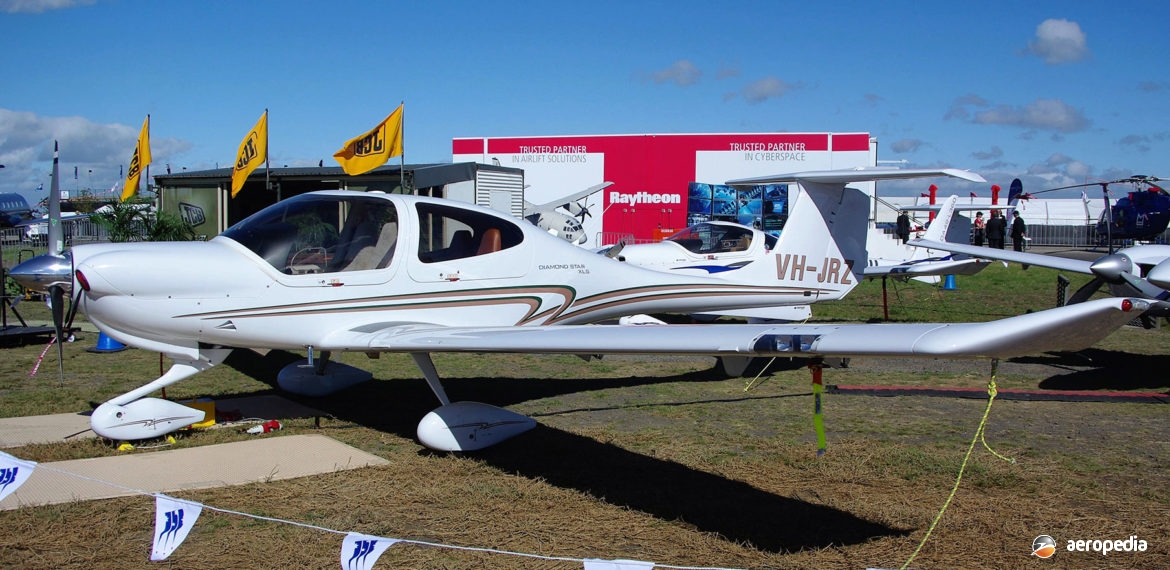Photograph:
Diamond DA-40 VH-JRZ (c/n 40.1078) at Avalon, VIC in March 2011 (David C Eyre)
Country of origin:
Austria
Description:
Four-seat light touring aircraft
Power Plant:
One 134 kw (180 hp) Lycoming IO-360 four-cylinder horizontally-opposed air-cooled engine
Specifications:
- Wingspan: 12 m (39 ft 4 in)
- Length: 8 m (26 ft 3 in)
- Height: 2 m (6 ft 6 in)
- Wing area: 13.5 m² (145.3 sq ft)
- Max speed: 330 km/h (205 mph)
- Cruising speed at 75% power at 1,981 m (6,500 ft): 270 km/h
- Stalling speed: 84 km/h (52 mph)
- Initial rate of climb: 326 m/min (1,070 ft/min)
- Range with 45 mins reserve: 1,480 km (1,100 miles)
- Empty weight: 700 kg (1,543lb)
- Useful load: 450 kg (992 lb)
- Loaded weight: 1,150 kg (2,535 lb)
History:
The DA-40 series of light aircraft has been built by Diamond Aircraft Industries at its facility south of Vienna in Austria. This company, which had previously been known as HOAC, had built more than 1,700 examples of the Katana series and had also produced the Dimona series.
The DA-40 series was a tricycle undercarriage all-composite aircraft aimed at the market for light aircraft with reasonable power, the smoothness of the design producing reduced drag, a reduction in maintenance costs, no metal fatigue problems, lower noise level and a lower empty weight. Most fittings were made of stainless steel and the manufacturer stated the aircraft could be permanently parked outside without risking major paintwork deterioration or long-term corrosion problems.
Normal fuel capacity was 150 litres (33 Imp gals) but a 200 litre (44 Imp gal) tank was available as an option. Design load was +3.8/-1.52 in the normal category and baggage capacity was 30 kg (66 lb). The front seats were integrated into the fuselage structure and different sized pilots were accommodated by adjustable rudder pedals with toe brakes. The wing was of high aspect ratio and was of double spar design, featuring laminar airflow and triangular raised wingtips to minimise induced drag. The flaps spanned over 60 per cent of the wing.
By late 2001 the manufacturer announced there were 250 aircraft on their order books and it planned to increase production to 22 aircraft a month. In 2002 a new variant appeared fitted with the Thielert TAE 125 Turbodiesel, this engine providing 101 kw (135 hp) at a propeller speed of 2,300 rpm and maintaining this power from sea level up to 3,048 m (10,000 ft). The standard 150 litres (33 Imp gals) of fuel provided a cruising range with 45 mins reserve of 1,389 km (863 miles) at a speed of 250 km/h (155 mph) at 60 per cent power at 3,658 m (12,000 ft). Range with the optional tank was 2,037 km (1,266 miles).
Thielert had commenced producing engines at its facility in Lichtenstein, production reaching 2,000 engines by that time, but problems were experienced and the company closed.
First of the series to arrive in Australia was VH-YPG (c/n 40012) with a Lycoming IO-360 engine. The first Diamond DA-40 Star fitted with the diesel engine was imported for an Australian operator, arriving early in 2003 and becoming VH-PDQ (c/n D4.006) at Katherine, NT in May 2003, followed by VH-PXA (c/n D4.310) and VH-YHM (c/n D4.308), the latter two for the Australian Wings Academy at Tugun, QLD.
First in New Zealand was ZK-SFH (c/n D.4037), a DA-40-TDI fitted with the Thielert diesel engine.
In 2009 the Massey University in New Zealand announced it had ordered 12 examples of the DA-40 for pilot training, and the type has become popular with training organisations turning out pilots for airline work.
In mid 2020 the Qantas Group Pilot Academy, based at Parafield, SA, ordered 20 DA-40XLT aircraft for operation from its new facility at Wellcamp Airport near Toowoomba, QLD. The Academy’s fleet at that time at Parafield included eight DA-42s, 50 DA-40s, two Cap 10Bs, two Grob 115s, four Socata TB-10s and four Schweizer 269C-1s for helicopter training. Plans were for 28 DA-40s and six DA-42s would be placed in opertion at Toowoomba. The Academy has been involved in training pilots for a number of airlines.

